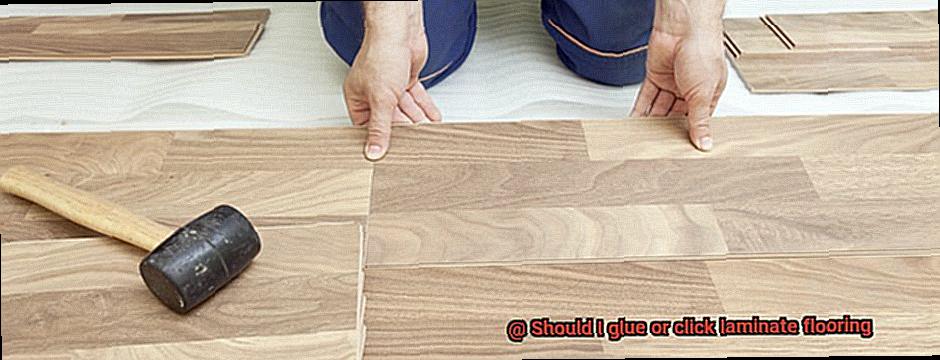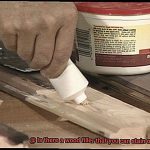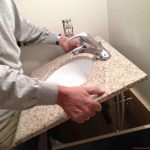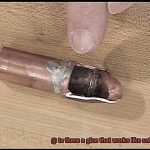Are you ready to give your home a budget-friendly makeover? New flooring can breathe new life into any room and turn it into a work of art. Laminate flooring is a popular choice due to its affordability, durability, and ease of installation. But before you start your project, you might be wondering, “Should I glue or click laminate flooring?”
You might think that all flooring is the same, but choosing between glue and click laminate flooring can make a significant difference in the outcome. Glue-down laminate requires an adhesive to keep the planks secured in place while click laminate locks each plank together like puzzle pieces.
Both methods have their advantages and disadvantages, including cost, installation difficulty, and durability. Ultimately, which one you choose depends on your lifestyle, budget, and the room’s purpose.
In this blog post, we will dive deeper into the differences between glue and click laminate flooring so that you can make an informed decision about which option is right for you. We’ll also provide a step-by-step guide on how to install both types of laminate flooring so that your decision-making process becomes more comfortable.
So grab yourself a cup of coffee or tea, sit back and relax as we take you through everything you need to know about choosing between glue and click laminate flooring.
Advantages of Glue-Down Laminate Flooring
Contents
- 1 Advantages of Glue-Down Laminate Flooring
- 2 Disadvantages of Glue-Down Laminate Flooring
- 3 Advantages of Click-Lock Laminate Flooring
- 4 Disadvantages of Click-Lock Laminate Flooring
- 5 How to Choose Between Glue and Click for Laminate Flooring
- 6 DIY Tips for Installing Glued or Clicked Laminate Flooring
- 7 Tips to Prevent Noisy or Shifting Laminate Floors
- 8 Conclusion
When it comes to choosing the right flooring for your home, laminate options have become increasingly popular in recent years. One type of laminate flooring that stands out is glue-down laminate. Installing this type of flooring involves applying adhesive to the subfloor and pressing the laminate planks into place. Here are some advantages of choosing glue-down laminate flooring:
- Increased Stability: Glue-down installation creates a stronger and more stable floor than click-lock. The adhesive used creates a bond between the subfloor and the laminate planks, preventing any shifting or movement over time. This makes it an ideal choice for high-traffic areas or homes with pets or children.
- Versatility in Installation: Unlike click-lock, glue-down can be installed over slightly uneven or rough subfloors, providing more options when it comes to choosing the location for your new flooring. This flexibility extends to different types of subfloors, including concrete, wood, or even existing vinyl.
- Better Water Resistance: With no spaces between the planks, there is no chance for water or moisture to seep through, making glue-down laminate a good choice for areas prone to spills or high humidity. It is also less likely to warp or buckle in areas with high moisture levels.
- Affordability: The simpler installation process means lower costs for both materials and labor, which can be a major advantage for those on a budget. Without the need for interlocking mechanisms or special tools, this option is often less expensive than click-lock laminate.
Disadvantages of Glue-Down Laminate Flooring
Glue-down laminate flooring may seem like the perfect solution, but before you make a final decision, it’s important to consider the potential disadvantages that come with this installation method.
One major drawback of glue-down laminate flooring is that it can be incredibly difficult to remove. When the time comes to replace your flooring, you’ll need to use forceful tools and potentially cause damage to your subfloor in order to get the planks up. This can be a costly and time-consuming process, so it’s worth considering if you plan on changing your flooring in the future.
Another issue to keep in mind is the risk of moisture damage. If any moisture seeps into the adhesive layer, it can weaken the bond between the planks and the subfloor over time. This can lead to warping, buckling, and other issues with your flooring. If you live in a particularly humid or wet climate, glue-down laminate may not be the best option for you.
In addition, it’s important to ensure that your subfloor is suitable for glue-down installation. If your subfloor is uneven or not perfectly level, it can create gaps between the planks and the subfloor. This can cause them to shift and become loose over time, leading to potential safety hazards.
Lastly, some people may find that glue-down installation is more difficult and time-consuming than other methods. It requires precision and care to ensure that each plank is securely glued in place without any air pockets or gaps. This may not be the best option if you’re looking for a quick and easy installation process.
Advantages of Click-Lock Laminate Flooring
Look no further than click-lock laminate flooring. This popular choice has taken the market by storm, and it’s not hard to see why.
One of the main advantages of click-lock laminate flooring is its easy installation process. Unlike traditional glue-down options, this flooring doesn’t require any special adhesives or tools. Simply snap the planks together and voila – your new flooring is installed in no time. It can also be installed over existing flooring, saving you time, money, and the headache of removal.
What’s more, click-lock laminate flooring is incredibly low-maintenance. It can be easily cleaned with a simple damp mop or vacuum cleaner, and it doesn’t trap dust or allergens like carpet does. This means that it’s an excellent choice for allergy sufferers.
But that’s not all – click-lock laminate flooring is also impressively durable. With its resistance to scratches, dents, and stains, it can handle high-traffic areas of your home without showing signs of wear and tear. Plus, its moisture-resistant properties make it ideal for use in bathrooms and kitchens.
Last but not least, click-lock laminate flooring offers an incredible range of styles and colors to choose from. Whether you’re after the timeless elegance of hardwood, the sleek look of tile, or the natural appeal of stone, there’s a click-lock laminate option that will fit your design preferences perfectly.
Disadvantages of Click-Lock Laminate Flooring
While it may seem like a convenient and affordable option, it’s important to understand the potential disadvantages before making a decision. As an expert on laminate flooring, I have researched and compiled a list of downsides to click-lock laminate flooring that you should consider.
Firstly, limited repair options are a significant disadvantage. Unlike glued laminate flooring, click-lock planks cannot be easily replaced without damaging the surrounding planks. This can result in a costly and time-consuming process if any plank becomes damaged.
Moisture resistance is also an issue with click-lock laminate flooring. It is not as resistant to moisture as glued laminate flooring, which can cause warping or buckling if spills or humidity penetrate the seams between planks. This can be especially problematic in areas prone to moisture, such as bathrooms and kitchens.
In addition to moisture resistance, noise is another concern with click-lock laminate flooring. The locking mechanism between planks creates a clicking sound that may be amplified by an uneven subfloor, making it more noticeable. This can be less of an issue in areas with a level subfloor, but it’s still something to keep in mind.
When it comes to durability, click-lock laminate may not hold up as well over time as glued laminate. The locking mechanism can weaken over time, leading to gaps and movement between planks. This can result in a less stable and durable flooring option.
Lastly, design options may be limited with click-lock laminate flooring due to the specific thickness and shape required for the locking mechanism. This means fewer design possibilities than with glued laminate flooring.
How to Choose Between Glue and Click for Laminate Flooring
Choosing between glue and click installation methods can be overwhelming. To make an informed decision, several factors need to be considered.
Subfloor Type
The type of subfloor you have plays a significant role in determining the installation method. If you have a concrete subfloor, gluing is recommended as it provides a stronger and more stable base. Conversely, if you have a wooden subfloor, clicking may be the better option as it accommodates flexibility and movement.
Experience Level
Experience level is another critical factor when choosing between glue and click installation methods. If you’re new to DIY projects, clicking may be the better option because it’s easier and more beginner-friendly. However, gluing can be more challenging as it requires even adhesive application across the entire surface and proper alignment of planks.
Type of Laminate Flooring
The type of laminate flooring being installed also influences the choice between glue and click installation. Some manufacturers recommend specific installation methods for their products, so it’s crucial to review the instructions carefully before making a decision.
Location of Installation
The location of installation is another essential factor that needs careful consideration. Glue-down installation is best for high foot traffic areas such as commercial spaces or busy households due to its additional stability that reduces the likelihood of planks shifting or coming loose over time. On the other hand, click installation is better suited for areas with less foot traffic such as bedrooms or home offices.
Type of Planks
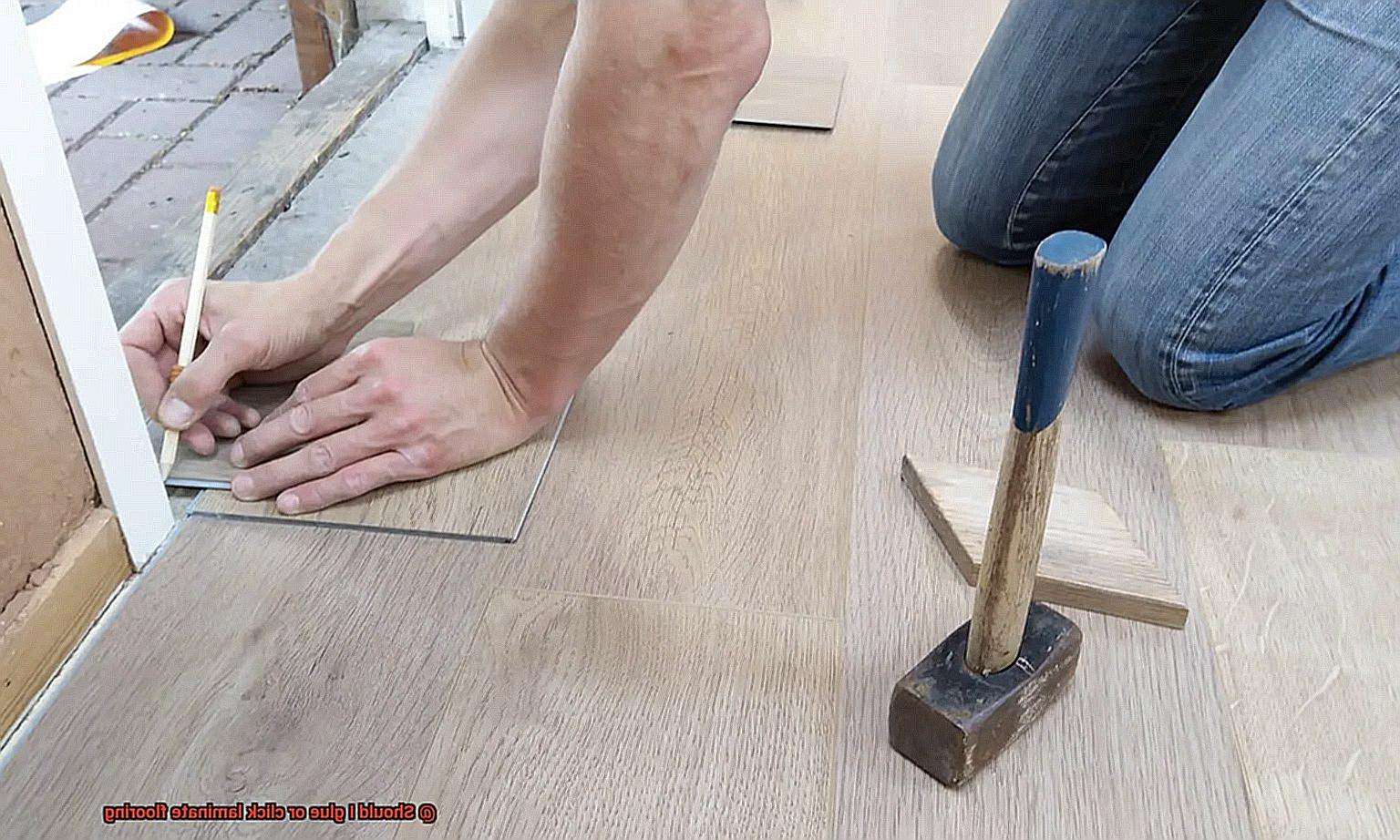
Finally, the type of planks used can also influence the choice between glue and click installation. Thicker laminate planks may require gluing for enhanced stability, while thinner planks may be easier to install using click installation.
DIY Tips for Installing Glued or Clicked Laminate Flooring
Laminate flooring is a popular choice due to its affordability, durability, and ease of installation. However, before you begin, you need to decide whether you want to install glued or clicked laminate flooring. In this article, we will provide five sub-sections of DIY tips for installing both types of laminate flooring.
Prepare Your Subfloor
Before starting the installation process, it is essential to prepare your subfloor. The subfloor must be clean, dry, and level to ensure the laminate flooring sits evenly and won’t warp or buckle over time. Start by removing any existing flooring and debris from the subfloor. If there are any bumps or uneven areas, address them before beginning the installation process.
Measure Twice, Cut Once
Measure your space accurately before cutting any planks. You don’t want to end up with uneven cuts or wasted materials that can add up quickly. Double-check your measurements before making any cuts and make sure to have extra planks on hand in case of mistakes.
Leave Room for Expansion
One of the most critical aspects of installing laminate flooring is leaving room for expansion. Laminate flooring can expand and contract with changes in temperature and humidity. To prevent buckling or warping, leave a small gap between the edge of the flooring and the wall. The recommended gap size is usually around ¼ inch.
Follow Manufacturer’s Instructions
Different brands of laminate flooring may have unique installation instructions or specific requirements for using glue versus clicking. Be sure to read and follow these instructions carefully to ensure a successful installation.
This includes applying adhesive correctly (if using glue) and using spacers to maintain the proper gap size.
Use Proper Tools
Having the right tools can make a big difference in the ease and accuracy of your installation.
Make sure you have a saw, spacers, tapping block, and pull bar on hand. A tapping block is especially useful for clicking laminate flooring into place without damaging the planks.
It is also essential to protect your knees with knee pads or a cushion to prevent discomfort during the installation process.
Tips to Prevent Noisy or Shifting Laminate Floors
These issues can not only be annoying, but they can also create safety hazards. To prevent noisy or shifting laminate floors, consider the following tips.
Ensure a Clean and Level Subfloor
Before installation, clean and level the subfloor. Any debris or bumps can cause the laminate planks to shift or creak. A clean and level subfloor will provide a stable foundation for your laminate flooring.
Choose the Right Type of Laminate Flooring
Different types of laminate flooring have different levels of durability and noise resistance. If you have a high-traffic area or are concerned about noise, consider glue-down laminate flooring instead of click-lock options. Glue-down laminate flooring is secured directly to the subfloor with adhesive and can be more stable and quieter.
Proper Installation is Key
Proper installation is crucial in preventing noisy or shifting laminate floors. Follow manufacturer instructions and use the correct tools to ensure that the planks are properly locked in place. Leave a small gap between the flooring and walls to allow for expansion and contraction due to temperature and humidity changes.
Use Underlayment for Cushioning
An underlayment can provide a cushioning effect and absorb sound, preventing noise from traveling throughout the room. It also helps level out any small imperfections in the subfloor.
Regular Maintenance is Essential
Regular maintenance can help prevent noisy or shifting laminate floors. Avoid exposing the flooring to excessive moisture and use felt pads on furniture legs to prevent scratches and dents. Regularly sweeping or vacuuming the floor can also remove any debris that may cause shifting or noise.
1UoRb3SJg24″ >
Conclusion
In summary, the decision to glue or click your laminate flooring can be overwhelming. However, it’s important to weigh the pros and cons of each method before making a final choice. Glue-down laminate offers benefits such as enhanced stability, versatile installation options, better water resistance, and affordability. Nevertheless, it can be tough to remove, may pose risks of moisture damage, and requires a suitable subfloor for installation.
Alternatively, click-lock laminate is easy to install, low-maintenance, durable and comes in various design options. However, it might have limited repair options and less moisture resistance than glued laminate flooring. Additionally, locking mechanisms over uneven subfloors or underlayment materials could cause noise concerns.
When deciding between the two methods for your home renovation project, consider factors like subfloor type and condition, experience level with DIY projects or hired professionals’ help needed for installation process. Moreover, think about where you’ll install the flooring – high traffic areas versus low traffic areas like bedrooms or home offices – the type of planks used in flooring; and manufacturer’s instructions on specific requirements for using glue versus clicking.
By following proper installation techniques and regular maintenance routines like cleaning up spills immediately or using felt pads on furniture legs to prevent scratches and dents can prevent noisy or shifting laminate floors.

